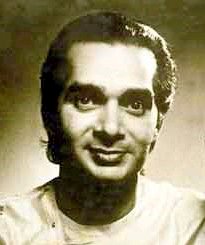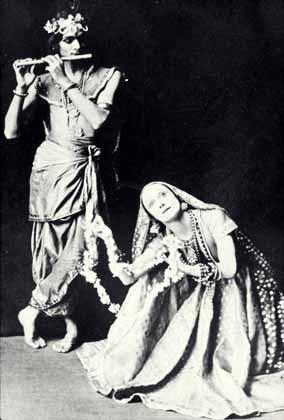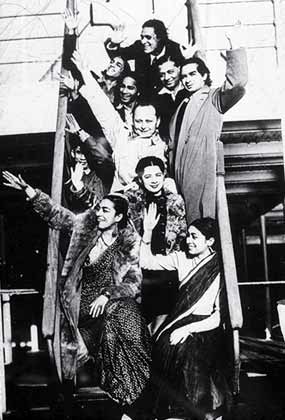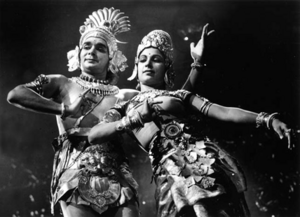Uday Shankar facts for kids
Quick facts for kids
Uday Shankar
|
|
|---|---|
 |
|
| Born | 8 December 1900 Udaipur, Udaipur State, British India
|
| Died | 26 September 1977 (aged 76) |
| Nationality | Indian |
| Occupation | Dancer, choreographer |
| Spouse(s) | Amala Shankar |
| Children | Ananda Shankar Mamata Shankar |
| Honours | Sangeet Natak Akademi Fellowship (1962) Padma Vibhushan (1971) |
Uday Shankar (born December 8, 1900 – died September 26, 1977) was a famous Indian dancer and choreographer. He was known for mixing different dance styles. He combined European theater methods with Indian classical dance. He also added parts of Indian folk and tribal dances.
Uday Shankar made this new style popular in India, Europe, and the United States. This happened in the 1920s and 1930s. He is seen as a leader of modern dance in India. In 1962, he received the Sangeet Natak Akademi Fellowship. This is the highest award from India's National Academy for Music, Dance, and Drama. In 1971, the Government of India gave him the Padma Vibhushan. This is the second highest award for civilians in India.
Contents
Early Life and Education
Uday Shankar Chowdhury was born in Udaipur, Rajasthan. He was the oldest son in a Brahmin family. His family came from Narail, which is now in Bangladesh. His father, Shyam Shankar Chowdhury, was a well-known lawyer. He worked for the Maharaja of Jhalawar when Uday was born. Uday's mother, Hemangini Devi, came from a rich land-owning family.
Uday's father was a very smart scholar. He studied at the University of Calcutta and University of Oxford. Because his father moved often for work, Uday lived with his mother and brothers. They stayed at his maternal uncle's house in Nasratpur. Uday studied in many places, including Nasratpur, Gazipur, Varanasi, and Jhalawar. In Gazipur, he learned music and photography from his teacher.
In 1918, when he was 18, Uday went to Mumbai. He trained at the J. J. School of Art and then at Gandharva Mahavidyalaya. His father had moved to London by then. There, his father married an English woman and worked as a lawyer. He also helped introduce Indian dance and music to Britain. Uday joined his father in London. In 1920, he started studying painting at the Royal College of Art. He danced at some charity shows his father organized. At one show, the famous Russian dancer Anna Pavlova was there. This meeting changed his life.
Developing a New Dance Style
Uday Shankar did not have formal training in any Indian classical dance forms. But his performances were very creative. From a young age, he saw both Indian classical and folk dances. He also saw ballet during his time in Europe. He decided to combine parts of these styles to create a new dance. He first called it "Hi-dance."
He studied Rajput painting and Mughal painting at the British Museum. This helped him turn Indian dance ideas into new movements. While in Britain, he met many artists. Later, he went to Rome to study art. There, he met more artists. This made him want to change Indian dance into a modern form.
A big moment came when he met the famous Russian ballerina Anna Pavlova. She was looking for artists to work on Indian themes. They created ballets based on Hindu stories. One was 'Radha-Krishna', a dance he performed with Anna. Another was 'Hindu Wedding'. These were part of her show, 'Oriental Impressions'. They performed at the Royal Opera House in London. He also created a ballet based on the Ajanta Caves paintings. This was performed across the United States. His dance style became known as 'Hi-dance', and later he called it 'Creative dance'.
He worked with Anna Pavlova for about a year and a half. Then, he started his own work in Paris.
Forming a Dance Company
Shankar came back to India in 1927. He brought with him a French pianist, Simon Barbiere, who was his student. He also brought a Swiss artist, Alice Boner, who wanted to study Indian art. Rabindranath Tagore welcomed him. Tagore also asked him to open a performing arts school in India.
In 1931, Shankar returned to Paris. There, he started Europe's first Indian dance company. He worked with Alice Boner, who was now his student. With musicians Vishnu Dass Shirali and Timir Baran, he created new music for his dances. His first shows were on March 3, 1931, at the Champs-Elysees Theatre in Paris. This theater became his main base as he toured Europe.
Soon, he went on a seven-year tour through Europe and America. His group was called 'Uday Shankar and his Hindu Ballet'. He first performed in the United States in January 1933 in New York City. His dance partner was Simkie, a French dancer. They toured 84 cities across the country.
Uday Shankar used European theater techniques in Indian dance. This made his art very popular in India and other countries. He helped bring new life to traditional Indian temple dances. These dances were known for their strict rules before. At the same time, his brother Ravi Shankar was helping to make Indian classical music popular worldwide.
In 1936, Leonard Knight Elmhirst invited him to Dartington Hall in England. Elmhirst had helped Rabindranath Tagore build Sriniketan. Uday Shankar stayed there for six months with his group and lead dancer, Simkie. He met other famous artists there. This experience added more energy to his expressionist dance.
In 1938, he made India his home base. He opened the 'Uday Shankar India Cultural Centre' in Almora, in the Uttarakhand Himalayas. He invited many great teachers for different Indian dance forms. These included Sankaran Namboodri for Kathakali and Kandappa Pillai for Bharatanatyam. Many artists and dancers joined him. His brothers Rajendra, Debendra, and Ravi also became his students.
The center closed in 1942 because it ran out of money. After that, he went south and made his only film, Kalpana (Imagination) in 1948. It was based on his dance, and he and his wife Amala Shankar danced in it. The film was made in Madras. In 2008, the film was digitally restored.
Uday Shankar settled in Kolkata in 1960. The "Uday Shankar Center for Dance" opened there in 1965. In 1962, he received the Sangeet Natak Akademi Fellowship. This was for his lifelong work in Indian dance.
Personal Life
Uday Shankar was the older brother of Ravi Shankar. He married his dance partner, Amala Shankar. They had a son, Ananda Shankar, born in 1942. They also had a daughter, Mamata Shankar, born in 1955.
Ananda Shankar became a musician and composer. He was known for mixing European and Indian music styles. Mamata Shankar became a dancer like her parents. She also became a noted actress. She runs the 'Udayan Dance Company' in Kolkata.
Legacy and Influence
Uday Shankar and Amala Shankar opened the Uday Shankar India Culture Centre in Kolkata in 1965. Amala Shankar was the director for 50 years. The school taught Uday Shankar's ideas about creative dance. It also offered training in classical dances like Kathakali and Bharatanatyam.
Amala Shankar worked hard to show the world Uday Shankar's dances. She also created new dances. The dance group from the center toured widely. Uday Shankar's ideas continue through his family and students. Amala Shankar recreated many of Shankar's major dance productions. She also created new performances. She believed in teaching dancers about costume and stage design too. She received the Padma Bhushan award in 1991.
Ananda Shankar's wife, Tanushree Shankar, continues to teach and perform his style of modern Indian dance. She runs the 'Tanushree Shankar Dance Company'. Uday Shankar's daughter, Mamata Shankar, also carries on his legacy. She runs her institution 'Udayan Kala Kendra'.
Many of Uday Shankar's students went on to become famous artists. Shanti Bardhan created Ramayana ballets. Guru Dutt, who attended his school, became a great film director in India. Lakshmi Shankar became a noted classical singer. She married Rajendra Shankar, Uday Shankar's younger brother. Zohra Sehgal had a successful career in theater, television, and film.
In December 1983, his younger brother, sitar player Ravi Shankar, organized a festival. It was called Uday-Ustav Festival in New Delhi. It celebrated 60 years since Uday Shankar's first professional performance. The festival included performances by his students, films, and music by Ravi Shankar. In 2001, celebrations for his 100th birthday were held at UNESCO in Paris. Dancers and scholars from around the world honored him. In Kolkata, a road in the Tollygunge area is named Uday Shankar Sarani after him.
Awards
- 1960: Sangeet Natak Akademi Award – 'Creative Dance'
- 1962: Sangeet Natak Akademi Fellowship
- 1971: Padma Vibhushan
- 1975: Desikottama, Visva-Bharati University
See also
- List of dancers






